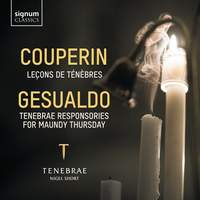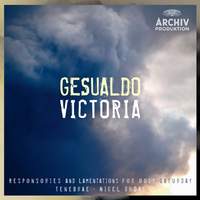Interview,
Nigel Short on Gesualdo and Couperin
 The intense drama of the Holy Week narrative has drawn from many composers some of their most powerful music - from extensive Passions to smaller-scale works. The English vocal ensemble Tenebrae, by any reckoning among the finest choirs in the world, have just released a recording of two such dramatic works - Couperin's three Leçons de Ténèbres and Gesualdo's Tenebrae Responsories for Maundy Thursday.
The intense drama of the Holy Week narrative has drawn from many composers some of their most powerful music - from extensive Passions to smaller-scale works. The English vocal ensemble Tenebrae, by any reckoning among the finest choirs in the world, have just released a recording of two such dramatic works - Couperin's three Leçons de Ténèbres and Gesualdo's Tenebrae Responsories for Maundy Thursday.
I spoke to Tenebrae's conductor Nigel Short about these two different responses to the themes and texts associated with the days leading up to Easter.
On the face of it, the Couperin Leçons and Gesualdo’s Responsories could hardly be more different – in scoring, in harmony and in mood. Do you think there are deeper commonalities between them than this?
Being composed roughly 100 years apart they are of course very different and belong to two very different styles of composition. The clear and obvious link is simply that these texts were very much in focus for most people and especially musicians during Passiontide. Believing in the church and its teachings was at the heart of everyone’s existence centuries ago, so it’s implausible to think any Christian soul would make it through Holy Week without being well acquainted with and acutely aware of the deep meaning of the texts used in the Offices of Tenebrae: some of the most intense, dramatic and poignant scriptures in all of Holy Week but specifically set in the Triduum Sacrum (Maundy Thursday, Good Friday and Holy Saturday).
Couperin takes the curious-seeming approach of setting to music the Hebrew letter at the head of each verse, as did most other composers who set these texts. How did this quirk of text-setting first arise – why was it so important to composers to include these letter-names in their music?
In the Hebrew Bible the use of alphabetic acrostic was a common way of achieving form – rhyme and repetition of metrical patterns didn’t exist until much later. The use of the 22 Hebrew letters is particularly evident in the Book of Lamentations in the Old Testament, in which every letter of the alphabet is used in each of of the four Chapters. By punctuating the verses with the Hebrew letters in alphabetical order (i.e. they start with Aleph, Beta, Ghimel and so on), composers were simply setting music to the complete Biblical texts and it would probably have raised an eyebrow had they left them out. From a musical point of view it gave composers a wonderful opportunity to write beautiful melismas, unencumbered by long stanzas. As such, it is often the case that some of the most beautiful moments in musical settings of the Lamentations occur during the Hebrew letters. Two of the finest examples of this are by Tallis in his Lamentations and Couperin in his Lecons de Ténèbres.
You mention that very little of Couperin’s sacred music was published in his lifetime, and much is lost. Almost every composer has had a portion of their works lost to posterity – but did Couperin fare unusually badly in this respect?
We have no way of really knowing how much music has been lost over the centuries by each composer, nor in many cases the specific reasons for its loss. Given the prolific output of Couperin, especially his works for harpsichord, it’s more of a sad assumption that he has fared worse than others.
Is there any particular significance to the shift from solo to duet texture for the final Leçon in this set?
No, not that we know of. It just seems to be something of a musical culmination in this particular collection of three of the Leçons. The level of complexity in the ornamentation in this music is regarded as something of a pinnacle of the Baroque era and perhaps Couperin sees the chance of stepping things up even further by doubling the vocal layers in the score.
You refer to the unusual distribution of parts in the Gesualdo, with two high sopranos, three tenors in the middle and a low bass. Is there any evidence as to whether this was a purely artistic decision or one of necessity, based on the available singers?
I think it’s difficult to know for sure if this was the intended pitch that Gesualdo had in mind, so I’m answering this from a purely personal perspective, and one that bears in mind the singers we have available from within the ranks of Tenebrae today. One could of course simply use a more standard distribution by having an alto instead of a third tenor, but I prefer to use this pitch and have the third line down in the score sung by a high tenor for added power and tension. Sung by an alto it would be considerably softer, and less capable of delivering key lines dramatically in a way that would match all the other parts. Were the pitch any lower then you would have both soprano parts at the top of the score unable to match the tenors and bass, who are all in a strong part of their range.
In our time, avant-garde music is often marked by bewilderment from audiences who are (necessarily) confronted with something unexpected. Do we know anything about how people in Gesualdo’s own era reacted to his uniquely adventurous idiom?
We are now aware of several other Italian composers who were composing in a similar fashion to Gesualdo. Sudden chromatic and harmonic shifts in the music that can change in an instant, as just one word appears in the text, seem unusual to our modern ears when comparing it to most other Renaissance music from the same era. However, having performed this music many times I can now say that the shock of the music does lessen over time. In fact as a modern listener/performer, the jolts that occur are something one can become accustomed to but still look forward to.
In a sense, much of the reason Gesualdo stands out is because he was a “school” of one; his extreme version of Mannerism died with him. Why do you think his harmonic innovations weren’t taken up and developed by the next generation of composers?
In fact I think they were taken up by others, but only much, much later. Gesualdo was something of a genius, as we know, and his music works: it’s successful and results in renditions that reflect the meaning of the texts he is setting. Perhaps his contemporaries tried to emulate this style but found it simply beyond their levels of expertise. It has often been written that Gesualdo was ‘ahead of his time’ and this point does tend to confirm this opinion. There is nothing else quite like it in the choral canon – that’s for sure.
Tenebrae, Nigel Short
Available Formats: CD, MP3, FLAC, Hi-Res FLAC
Tenebrae, Nigel Short
Available Formats: MP3, FLAC




